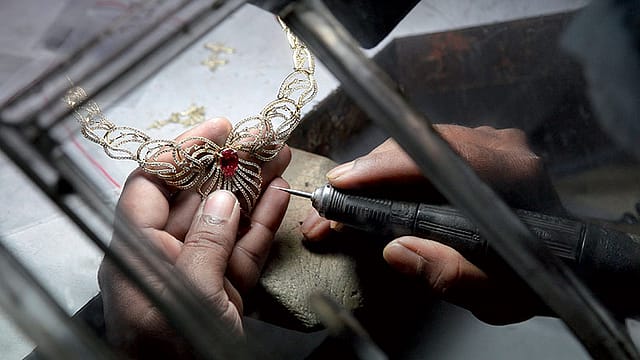Trump's tariff impact: India to lose 30% of gems, gold and jewellery exports
ADVERTISEMENT

US President Donald Trump's decision to impose a 50% tariff could severely impact India's gem and jewellery exports, as the United States is India's single largest market and accounts for over 30% of gems and jewellery exports from India.
"The United States is our single largest market, accounting for over $10 billion in exports—nearly 30% of our industry’s total global trade. A blanket tariff of this magnitude is severely devastating for the sector," said Kirit Bhansali, Chairman, Gem and Jewellery Export Promotion Council (GJEPC). Now, competing manufacturing hubs, such as Turkey, Vietnam, and Thailand, continue to enjoy significantly lower tariffs of 15%, 20%, and 19% respectively, making Indian products relatively less competitive in the US market.
He said nearly 85% of exports from SEEPZ SEZ, which provides 50,000 jobs, are directed to the US. For cut and polished diamonds, half of India’s exports are US-bound. With the revised tariff hike, the entire industry may come to a standstill, placing immense pressure on every part of the value chain—from small karigars to large manufacturers, he said.
"We are also concerned about the possibility of trade rerouting through low-tariff destinations such as Mexico, Canada, Turkey, UAE, or Oman—undermining the spirit of legitimate trade and impacting transparency," said Kirit Bhansali.
Despite the challenges, the Indian gems and jewellery sector is poised for growth and exploring newer markets, he said. The recent IIJS Premiere 2025, the world’s largest jewellery fair, estimated projected business for domestic players ranging from ₹70,000 crore to ₹1 lakh crore. The domestic market—currently pegged at $85 billion, is expected to grow to ₹130 billion in the next two years.
January 2026
Netflix, which has been in India for a decade, has successfully struck a balance between high-class premium content and pricing that attracts a range of customers. Find out how the U.S. streaming giant evolved in India, plus an exclusive interview with CEO Ted Sarandos. Also read about the Best Investments for 2026, and how rising growth and easing inflation will come in handy for finance minister Nirmala Sitharaman as she prepares Budget 2026.
Simultaneously, GJEPC is actively exploring new markets. The upcoming Saudi Arabia Jewellery Exhibition (SAJEX) is one such initiative aimed at opening fresh avenues in emerging regions and diversifying India’s export destinations, he said.
As a relief measure, the GJEPC demanded the Government to introduce a targeted scheme on the lines of Duty Drawback or reimbursement scheme, covering approximately 25–50% of the new tariffs imposed on gems and jewellery exports only to the USA from August to December 2025. This initiative aims to partially offset the impact of the new tariff structure, mitigate financial strain on exporters, reduce the risk of order cancellations, and help maintain India’s market share in an increasingly competitive and price-sensitive global market.
Financial assistance under the MAI Scheme is proposed to support the exploration of new markets beyond the traditional U.S. focus. This includes backing for the upcoming SAJEX jewellery exhibition, scheduled from 11th to 13th September 2025 in Jeddah, as well as the establishment of an India Jewellery Exposition Centre in Saudi Arabia, modelled on the IJEX-Dubai platform. The exporters also demands that lending institutions may be permitted to allow a deferment of interest of six months, from 1st August 2025 to 1st January 2026, as was done during the COVID-19 period.
By allowing reverse job work to SEZ, the SEZ units would be able to utilise their machinery and engage their labour for manufacture and supply of jewellery in the DTA which can be a saviour during this crisis. The duty should be on the value of duty foregone on the duty-free inputs used by the SEZ unit in manufacturing jewellery for DTA.
Permitting SEZ for reverse job work and DTA sales will support the SEZ to support and retain its workers/artisans/cutters (around 1.25 lakh) and survive at the threshold level amid this emergence situation. Given potential shipment delays, banks should be encouraged to extend pre-shipment loan due dates by at least 90 days without penalties.
Interest Equalisation Scheme: The interest equalisation scheme has served an important purpose as it has provided much-needed competitiveness to Indian exports, particularly to MSMEs, as the interest costs in India is much above that in competitor countries.
